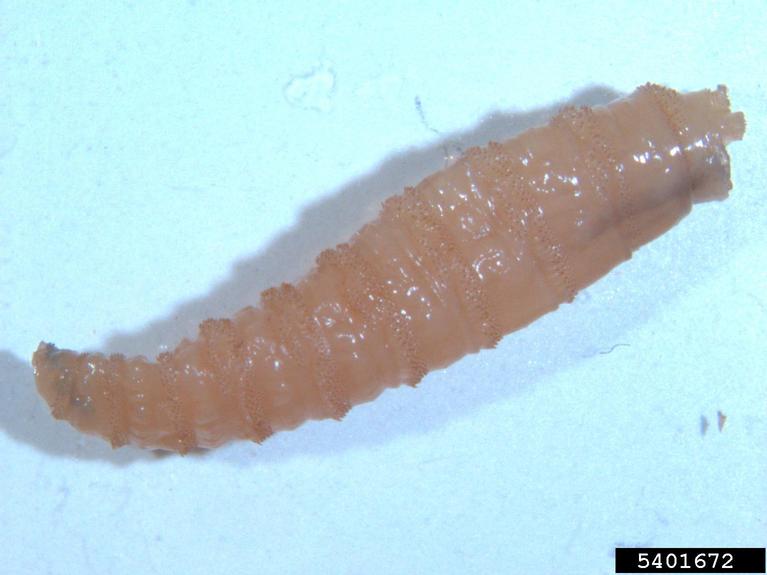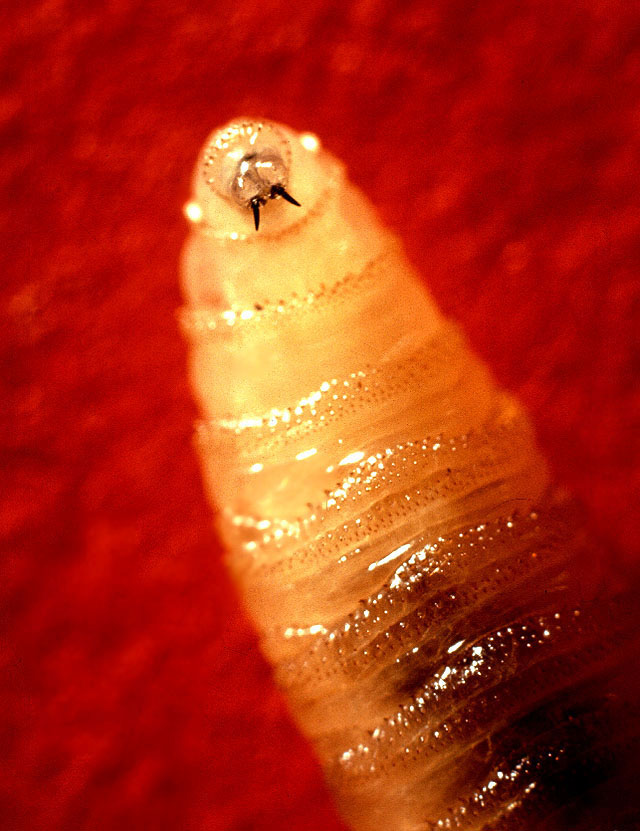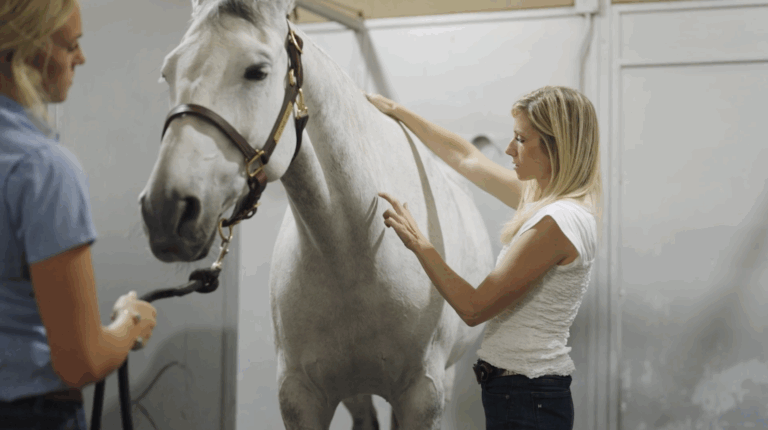
The northward resurgence of New World screwworm cases from Central America into Mexico has caused alarm within the veterinary community. In July 2025, the USDA went so far as to halt import of live cattle, horses, and bison from Mexico to curtail its spread.
To keep veterinarians and horse owners informed about this important topic, the American Association of Equine Practitioners hosted the webinar “Eye on the Fly: New World Screwworm Update,” sponsored by American Regent Animal Health, on Aug. 13. The panel of presenters—Drs. Sally DeNotta, Cody Egnor, Neil Gray, and Andrew Short—reviewed current risks and courses of action.
About New World Screwworm

New World screwworm (NWS) is a nonbiting fly whose parasitic larvae feed on the live tissues of warmblooded animals, explained Andrew Short, PhD, Professor of Insect Biodiversity at the University of Florida (UF). It gets its name because of the larvae’s resemblance to a screw as it burrows head-down into an animal’s flesh, he added.
Adult NWS flies are about three to five times the size of a house fly and can lay 350 eggs at a time—usually in a wound or a break in the skin, which can be as small as a tick bite. They can also lay eggs on mucous membranes. When the larvae hatch, they then burrow into the flesh and grow up to 2/3 of an inch long. Once their weeklong life cycle is complete, they burrow out of the animal and into the soil, pupate, and emerge as adults seven to 10 days later in ideal warm conditions.
To make matters worse, said Short, infestations create foul-smelling wounds that attract other screwworm females to lay more eggs in that wound. Mortality/morbidity occurs as a result of larvae burrowing deeper and deeper into an animal, infiltrating the body cavity, organs, or skull. In untreated cattle, he said, mortality can occur within 7-14 days.
Identification, Prevention, and Management

New World screwworm lesions look like wounds full of maggots, said Sally DeNotta, DVM, PhD, DACVIM, clinical associate professor in UF’s Department of Large Animal Clinical Sciences. They most commonly develop in wounds, lacerations, castration sites, and the umbilicus of foals. She advised veterinarians to watch for rapidly extensive maggot-filled wounds, signs of pain (restlessness, biting), decreased appetite and weight loss, and a foul odor.
Neil Gray, DVM, a Southern-California-based sport horse practitioner, shared photos and videos of NWS cases he has worked on during Equitarian Initiative trips to Central America. These examples might be useful in identifying infestations.
To prevent NWS infestations, practice prompt wound care after injuries and surgeries, monitor foal umbilici, apply topical repellents or larvicides, and keep open wounds covered, said DeNotta. Currently, there are no FDA-approved products to treat or prevent NWS. Treatment involves:
- Manually removing larvae. Clean and flush the wound thoroughly, and apply fly repellent, DeNotta said, adding that deep wounds might require debridement under local or general anesthesia. Then, monitor for reinfestation.
- Applying larvicidal compounds, such as ivermectin (sometimes topically) and permethrin sprays or pour-ons.
- Systemic therapy, most commonly ivermectin to kill remaining larvae, antibiotics to treat secondary bacterial infections, and NSAIDs or analgesics for pain and inflammation.
If horse owners suspect a horse has New World screwworm, they should:
- Contact their veterinarian.
- Seek treatment for the animal immediately.
- Do not move the horse except to transport him to the veterinary clinic.
- Keep the animal in a safe, contained space.
- Spray down potentially infested areas with insect sprays.
- Collect any maggotlike specimens and save them in rubbing alcohol.
- Wear gloves around the horse and lesion.
Current Status and Initiatives
In June 2025, the USDA announced its Five-Pronged Plan to address NWS:
- Stop the pest from spreading in Mexico.
- Protect the U.S. border at all costs.
- Maximize our readiness.
- Take the fight to the screwworm.
- Innovate our way to continued success.
Cody Egnor, DVM, of the USDA Animal and Plant Health Inspection Service (APHIS), listed the three key interventions for NWS eradication:
- Sterile insect technique (SIT).
- Robust regulatory controls, including movement of people and animals, enhanced quarantine practices, animal control, and inspection checkpoints.
- Field surveillance and stakeholder engagement.
The sterile insect technique involves producing and releasing sterile male screwworms into the environment to mate with wild females, which only mate once per life span. The COPEG (Commission for the Eradication and Prevention of Screwworm) sterile fly production and dispersal center in Panama, for instance, produces 100 million insects per week and conducts weekly dispersal flights. Egnor explained that these dispersal operations continue to shift northward into Central America to stop NWS spread and reestablish a biological barrier.
The USDA, meanwhile, announced it will provide $21 million to help renovate a facility in Metapa, Mexico, to produce NWS flies. Egnor said the USDA is also building a sterile insect dispersal facility in southern Texas and considering the development of a domestic sterile fly production facility in the U.S.
U.S. Import Status and Reporting Requirements

On July 7, 2025, a new screwworm case was reported in Veracruz, Mexico, which is about 160 miles north of the sterile fly dispersal grid. On July 9, the USDA suspended live cattle, horse, and bison imports through the southern border due to the continued and rapid northward spread of NWS in Mexico.
USDA-accredited veterinarians must maintain a knowledge of reportable and potential foreign animal diseases, said Egnor, but even nonaccredited vets should know the triggers for unusual animal disease presentations (strange looking flies, lesions, etc.) and know whom to report it to. He said neglecting to report cases to a USDA Area Veterinarian in Charge or State Animal Health Official can cause:
- Taxpayers millions of dollars in response efforts.
- Unnecessary animal suffering and death.
- Potential risk to human health, because the fly can infect humans as well.
- Loss of your accreditation.
He reminded veterinarians that wildlife can play a major role in disease outbreaks, and their symptoms should be reported as well.
Follow these steps when collecting and submitting NWS samples:
- Contact a State Animal Health Official to get a foreign animal disease number and coordinate sample submission.
- Each animal infested gets their own labeled vial.
- Collect and submit all that you can—eggs, larvae/maggots of various shapes and sizes, pupae, or adults (dry, no alcohol).
- Cover egg and larvae specimens with 70% ethanol or isopropyl alcohol (not formalin) and store flies dry in plain tube.
- With gloves and forceps, sample multiple sizes of larva from different depths of the wound.
- Take photos, which Egnor said are really important in these outbreaks.
Take-Home Message
To prepare for NWS, Egnor advised veterinarians to establish strong veterinarian-client-patient relationships and lines of communication with horse owners. Try to implement lower-risk husbandry practices, and review biosecurity with clients. Also review fly prevention and control, as well as wound treatment and management practices. Know how to collect samples and where to send them.
The USDA provides extensive NWS outreach materials that you can access online.
Watch the webinar in its entirety at https://www.youtube.com/watch?v=-EdWemv_RTQ.
Related Reading
- New World Screwworm Poses Threat to U.S. Horses
- Equine, Livestock Imports Suspended Along Southern Border as NWS Spreads North
- Disease Du Jour: Equine Infectious Disease Patterns and Threats
Stay in the know! Sign up for EquiManagement’s FREE weekly newsletters to get the latest equine research, disease alerts, and vet practice updates delivered straight to your inbox.







